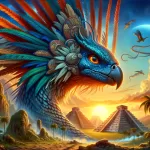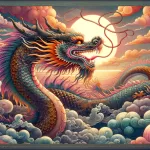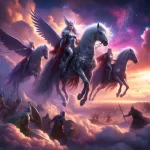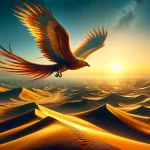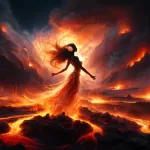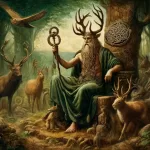Morrigan’s Veil: Shadows of the Celtic Battlefields
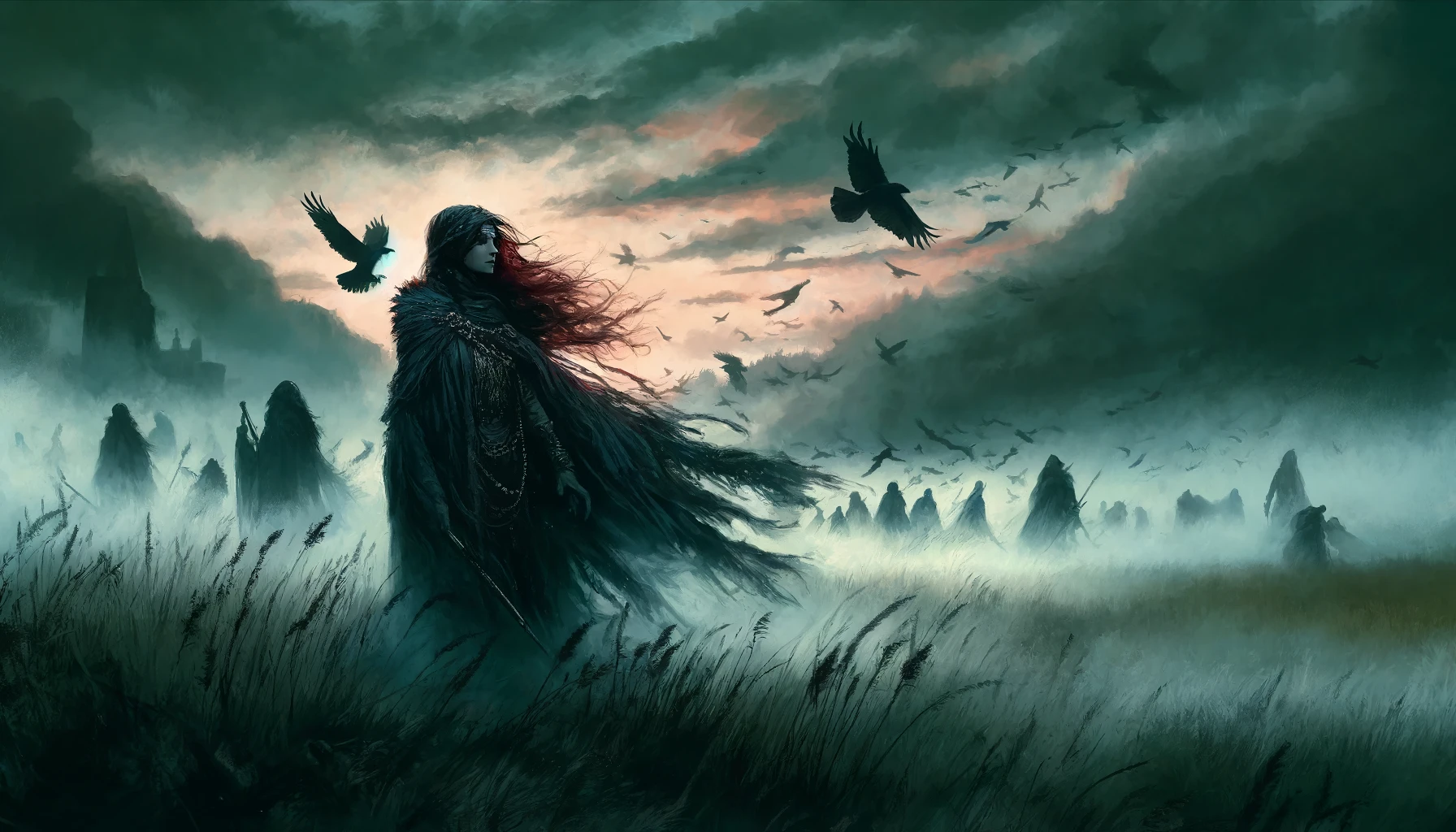 ‘Morrigan’s Veil: Shadows of the Celtic Battlefields’ is a compelling digital artwork that delves deep into the enigmatic aura of the Morrigan, a pivotal figure in Celtic mythology. Known as the Phantom Queen, she presides over war, fate, and death, influencing the outcome of conflicts with her supernatural powers. This piece captures the Morrigan in a moment of spectral beauty as she traverses the fog-laden battlefields, her form shrouded in a cloak of raven feathers, reflecting her connection to these ominous birds.
‘Morrigan’s Veil: Shadows of the Celtic Battlefields’ is a compelling digital artwork that delves deep into the enigmatic aura of the Morrigan, a pivotal figure in Celtic mythology. Known as the Phantom Queen, she presides over war, fate, and death, influencing the outcome of conflicts with her supernatural powers. This piece captures the Morrigan in a moment of spectral beauty as she traverses the fog-laden battlefields, her form shrouded in a cloak of raven feathers, reflecting her connection to these ominous birds.
The artwork portrays her amidst an ancient Celtic landscape at dusk, with the last light casting long shadows and illuminating her fierce, yet solemn face. Her eyes, a piercing shade of crimson, scan the horizon, foreseeing the fate of warriors with a gaze that is both commanding and sorrowful.
Rendered with a blend of ethereal digital brushwork and dynamic lighting effects, the scene is bathed in a palette of deep grays and muted greens, punctuated by the stark black of her feathered cloak. Wisps of mist swirl around her, adding to the mystical and foreboding atmosphere of the setting.
‘Morrigan’s Veil: Shadows of the Celtic Battlefields’ not only pays tribute to the Morrigan’s powerful role in Celtic lore but also invites viewers to ponder the deeper themes of destiny and the duality of creation and destruction that she embodies. It’s a visual exploration of the complex narratives woven into Celtic mythology, offering a glimpse into the mysterious forces that shaped the ancient Celtic world.
more background on this topic here –> https://irishwishes.com/the-morrigan-the-amazing-celtic-goddess/
Quetzalcoatl’s Ascent: Resurgence of the Feathered Serpent
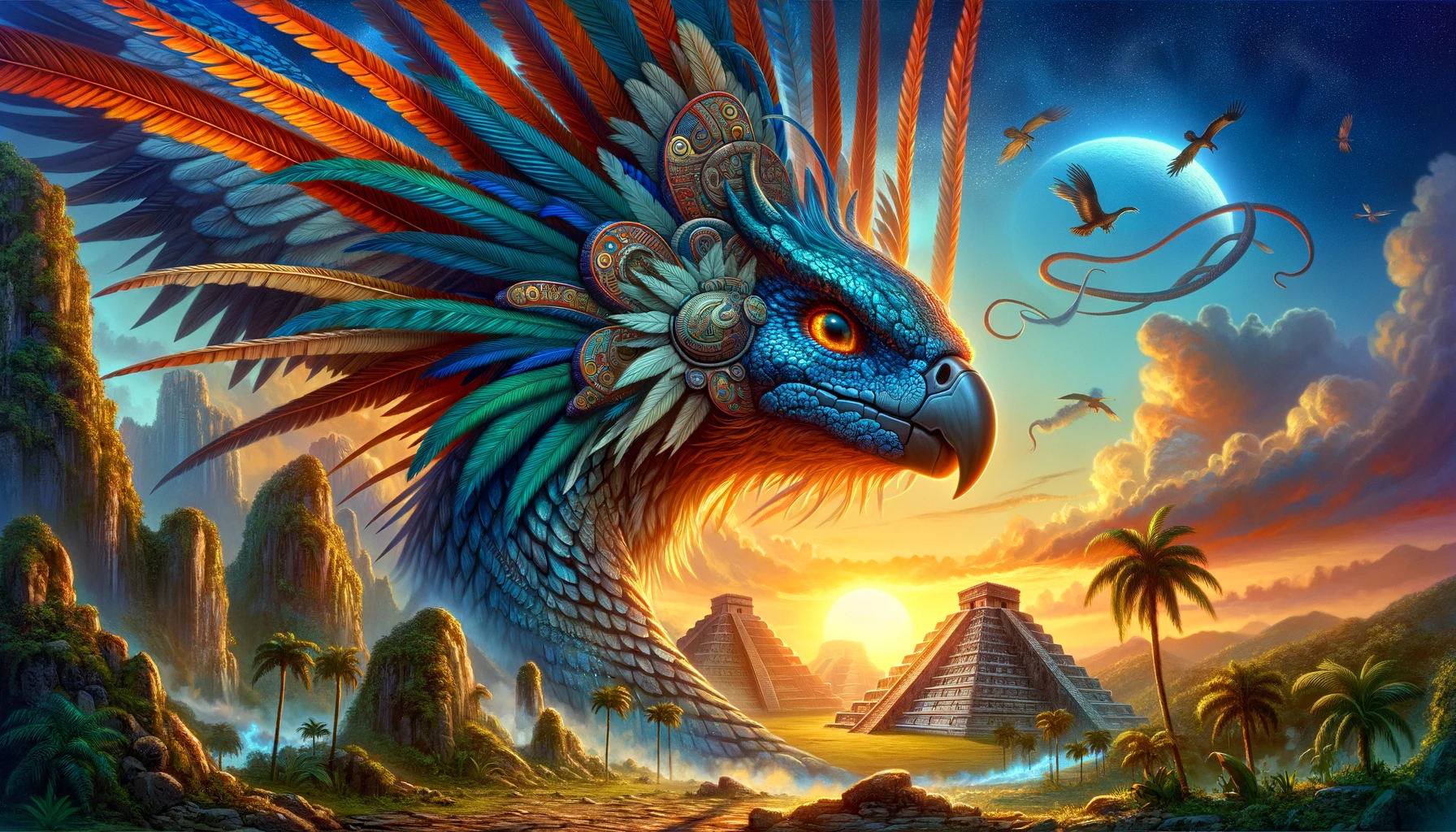 ‘Quetzalcoatl’s Ascent: Resurgence of the Feathered Serpent’ is a stunning digital artwork that vividly brings to life Quetzalcoatl, one of the most revered deities in Aztec mythology. This piece captures the moment of Quetzalcoatl rising above the ancient Mesoamerican landscapes, his body a magnificent blend of bird and serpent, symbolizing his dominion over the earth and the sky.
‘Quetzalcoatl’s Ascent: Resurgence of the Feathered Serpent’ is a stunning digital artwork that vividly brings to life Quetzalcoatl, one of the most revered deities in Aztec mythology. This piece captures the moment of Quetzalcoatl rising above the ancient Mesoamerican landscapes, his body a magnificent blend of bird and serpent, symbolizing his dominion over the earth and the sky.
The artwork showcases Quetzalcoatl in a dynamic pose, spiraling upwards with his vibrant, feathered scales glistening under the warm sunlight, reflecting the colors of the sky at dawn—brilliant blues, soft oranges, and fiery reds. His eyes emit a wise yet fierce gaze, commanding respect and admiration.
Rendered with a combination of photorealistic details and surreal elements, the digital brushwork emphasizes the textures of his feathers and scales, enhancing the mystical aura surrounding this deity. The background features iconic Aztec pyramids and lush tropical foliage, which frame Quetzalcoatl’s figure, reinforcing his role as a creator god and the bringer of civilization.
‘Quetzalcoatl’s Ascent: Resurgence of the Feathered Serpent’ not only pays homage to the rich tapestry of Aztec myths but also invites viewers to reflect on the themes of rebirth and renewal, central to Quetzalcoatl’s legends. It’s a visual celebration of the cultural depth and spiritual symbolism that Quetzalcoatl represents in the heart of Aztec lore.
Celestial Dragon: Guardian of the Eastern Skies
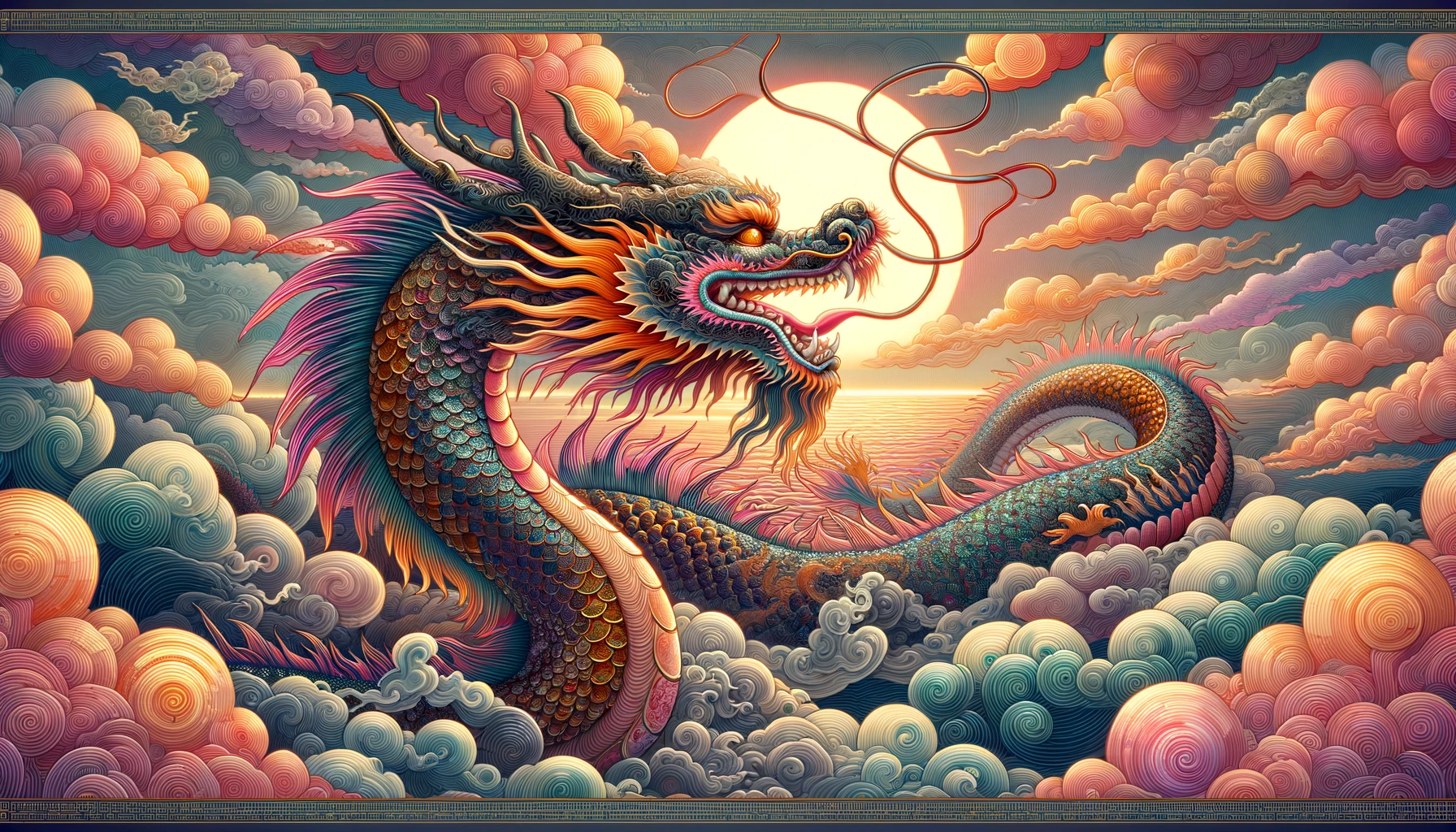 ‘Celestial Dragon: Guardian of the Eastern Skies’ is a breathtaking digital artwork that embodies the splendor and mystique of the Celestial Dragon, a revered figure in Chinese mythology. This piece captures the dragon as it coils through the clouds, its scales shimmering with the hues of dawn. The dragon’s eyes gleam with wisdom and ancient power, reflecting its role as the protector of the heavens and the bringer of rain, essential for prosperity and growth.
‘Celestial Dragon: Guardian of the Eastern Skies’ is a breathtaking digital artwork that embodies the splendor and mystique of the Celestial Dragon, a revered figure in Chinese mythology. This piece captures the dragon as it coils through the clouds, its scales shimmering with the hues of dawn. The dragon’s eyes gleam with wisdom and ancient power, reflecting its role as the protector of the heavens and the bringer of rain, essential for prosperity and growth.
The artwork is crafted with a fusion of traditional Chinese art styles and modern digital techniques, creating a dynamic interplay of colors and textures. The sky is a canvas of soft pinks and vibrant oranges, suggesting the break of dawn over the eastern horizon. The Celestial Dragon’s body flows elegantly through the clouds, adorned with intricate patterns that echo the art of Chinese calligraphy and silk paintings.
With every turn of its majestic body, the dragon seems to command the very elements, embodying the force of life and the harmony of nature. ‘Celestial Dragon: Guardian of the Eastern Skies’ not only celebrates this powerful symbol of Chinese culture but also invites viewers to delve deeper into the tales of cosmic balance and spiritual grace that dragons represent in Chinese lore.”
This description aims to transport the viewer into a world where myth and majesty converge, through the powerful yet graceful depiction of the Celestial Dragon.
Dragons in Chinese Art
Dragons are a common motif in traditional Chinese art. They appear in various forms:
- Ceramics and Sculpture: Dragons are intricately modeled in clay or carved into stone for decorations in temples and homes.
- Paintings and Calligraphy: Dragons are often painted alongside clouds or water, symbolizing their supposed control over rain and bodies of water. These artworks are considered auspicious, believed to bring good luck and prosperity.
- Textiles: Dragons are embroidered on imperial robes and traditional garments such as the Qipao (Cheongsam), especially for festive occasions or ceremonies, signifying the wearer’s strength and nobility.
Dragons in Festivals and Celebrations
Dragons are prominently featured in several Chinese festivals:
- Chinese New Year: The Dragon Dance is one of the highlights of Chinese New Year celebrations, performed to scare away evil spirits and to bring good luck and fortune. The dance involves a team of performers who manipulate a long flexible figure of a dragon using poles positioned at regular intervals along the length of the dragon.
- Dragon Boat Festival: Though primarily associated with the racing of dragon boats, these boats are adorned with dragon heads and tails, and the event itself is steeped in dragon imagery, celebrating both the agricultural and spiritual traditions that dragons symbolize.
Dragons in Contemporary Media and Popular Culture
- Cinema and Television: Dragons frequently appear in Chinese cinema and television, often in historical dramas or fantasy series that draw on mythological themes.
- Modern Art and Fashion: Contemporary Chinese artists and fashion designers often reinterpret traditional dragon motifs, blending them with modern aesthetics to create innovative designs that honor cultural heritage while appealing to modern tastes.
- Public Art and Architecture: Modern architecture in China sometimes incorporates dragon motifs, with some buildings and structures designed to resemble dragons, symbolizing prosperity and cultural pride.
Symbolic Importance
In all its uses, the dragon is seen not just as a mythological creature but as a symbol of the Chinese people themselves—strong, proud, and benevolent. It is a protector, carrying connotations of authority and good leadership, and it is deeply woven into the fabric of Chinese cultural identity, from everyday items to grand national celebrations.
Valkyries Descent: Twilight of the Battlefields
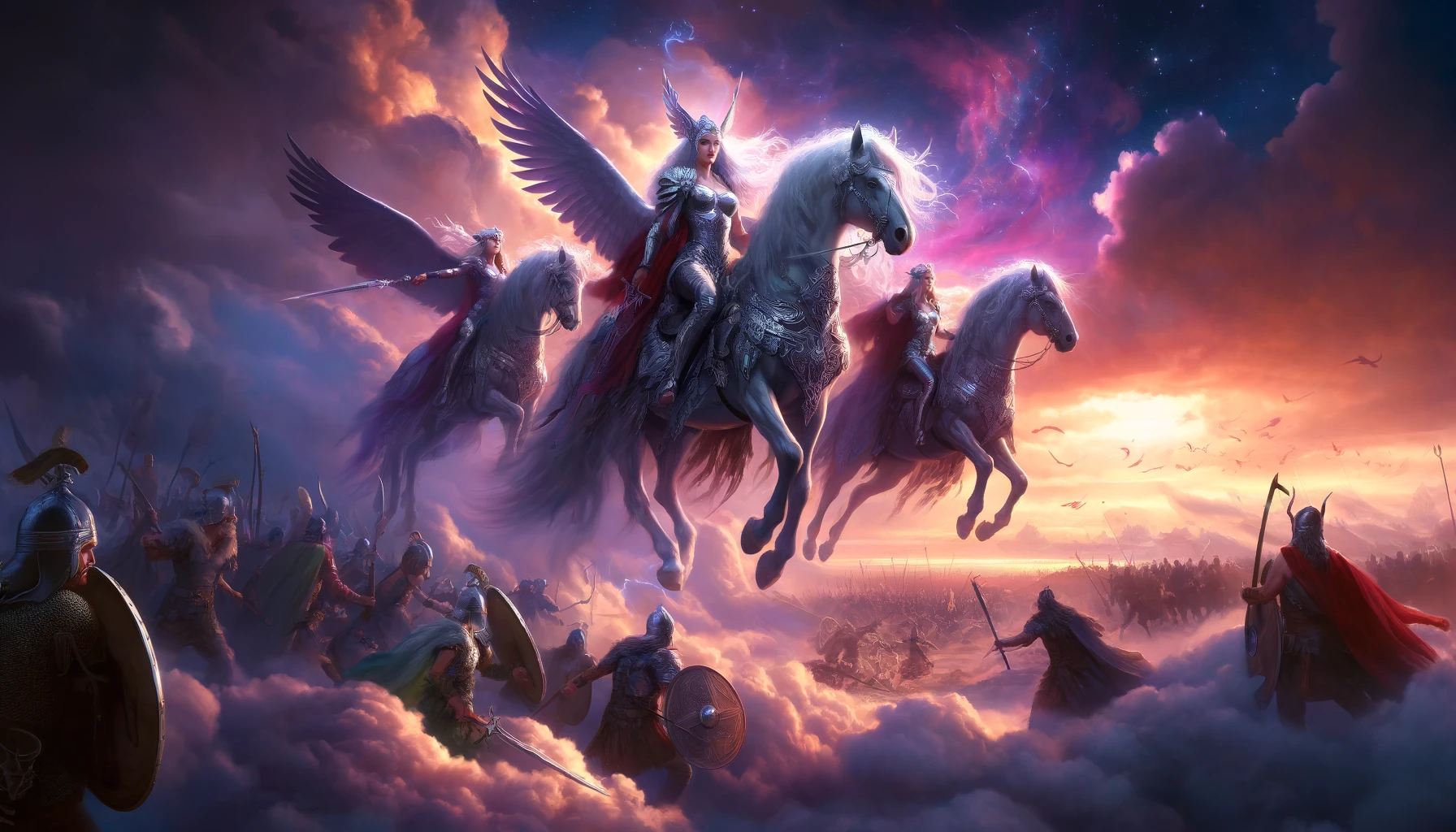 ‘Valkyries’ Descent: Twilight of the Battlefields’ is a dramatic digital artwork that captures the powerful essence of the Valkyries, the legendary figures from Norse mythology. This piece portrays the Valkyries as they descend through the tumultuous skies over an ancient battlefield at twilight. Their silhouettes are striking against the fading light, armored and majestic, riding ethereal horses that seem to gallop across the very clouds.
‘Valkyries’ Descent: Twilight of the Battlefields’ is a dramatic digital artwork that captures the powerful essence of the Valkyries, the legendary figures from Norse mythology. This piece portrays the Valkyries as they descend through the tumultuous skies over an ancient battlefield at twilight. Their silhouettes are striking against the fading light, armored and majestic, riding ethereal horses that seem to gallop across the very clouds.
The artwork is rendered with a dynamic blend of photorealistic and painterly digital techniques, enhancing the motion and ferocity of the scene. The sky is a canvas of deep purples and fiery oranges, reflecting the chaos and beauty of the final moments of battle. Below, the shadowy outlines of warriors clash, suggesting the mortal strife over which the Valkyries preside.
Each Valkyrie is depicted with individualized armor and weapons, resonating with the tales of their formidable combat skills and roles as choosers of the slain. Their expressions are both serene and resolute, embodying their dual role as harbingers of death and guardians of warrior spirits.
‘Valkyries’ Descent: Twilight of the Battlefields’ not only celebrates the mythic grandeur of these divine figures but also invites viewers to ponder the deeper themes of fate, valor, and the cyclical nature of life and death as portrayed in Norse legend.
Roc’s Dominion: Shadows Over the Sands
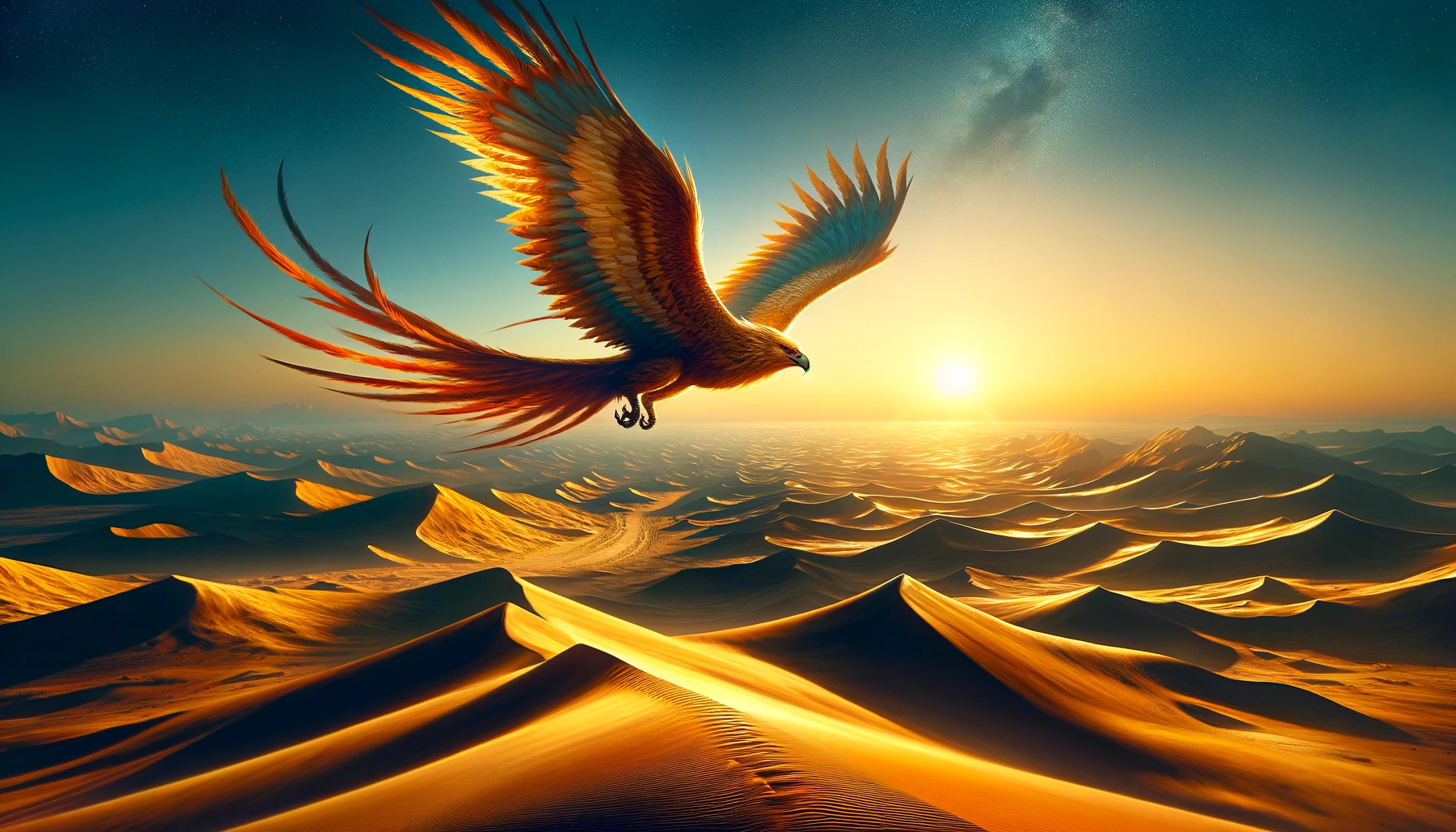 ‘Roc’s Dominion: Shadows Over the Sands’ is a majestic digital artwork that brings to life the legendary Roc from Arabian folklore. This piece portrays the immense bird soaring high above the arid desert landscapes, casting vast shadows over the golden dunes below. The Roc, with its expansive wingspan and formidable presence, is depicted at the moment of sunrise, when the first light of dawn illuminates its feathers, turning them into a tapestry of gold and bronze hues.
‘Roc’s Dominion: Shadows Over the Sands’ is a majestic digital artwork that brings to life the legendary Roc from Arabian folklore. This piece portrays the immense bird soaring high above the arid desert landscapes, casting vast shadows over the golden dunes below. The Roc, with its expansive wingspan and formidable presence, is depicted at the moment of sunrise, when the first light of dawn illuminates its feathers, turning them into a tapestry of gold and bronze hues.
The scene captures the bird as it glides effortlessly, its sharp eyes scanning the sands for signs of life. The artwork melds hyper-realistic digital brushwork with dynamic aerial perspectives, creating a vivid, lifelike depiction of the Roc in its natural, mythical habitat. The color palette is dominated by the warm tones of the desert at dawn—soft ambers, muted golds, and deep browns—contrasting dramatically with the bright azure of the morning sky.
‘Roc’s Dominion: Shadows Over the Sands’ not only highlights the might and majesty of the Roc but also invites viewers to explore the rich tapestry of Arabian myths. It celebrates the awe-inspiring aspects of mythical creatures and the landscapes they inhabit, encouraging a deeper appreciation for the stories that have traversed through centuries to stir our imaginations today.
Pele’s Dance: Flames of Creation
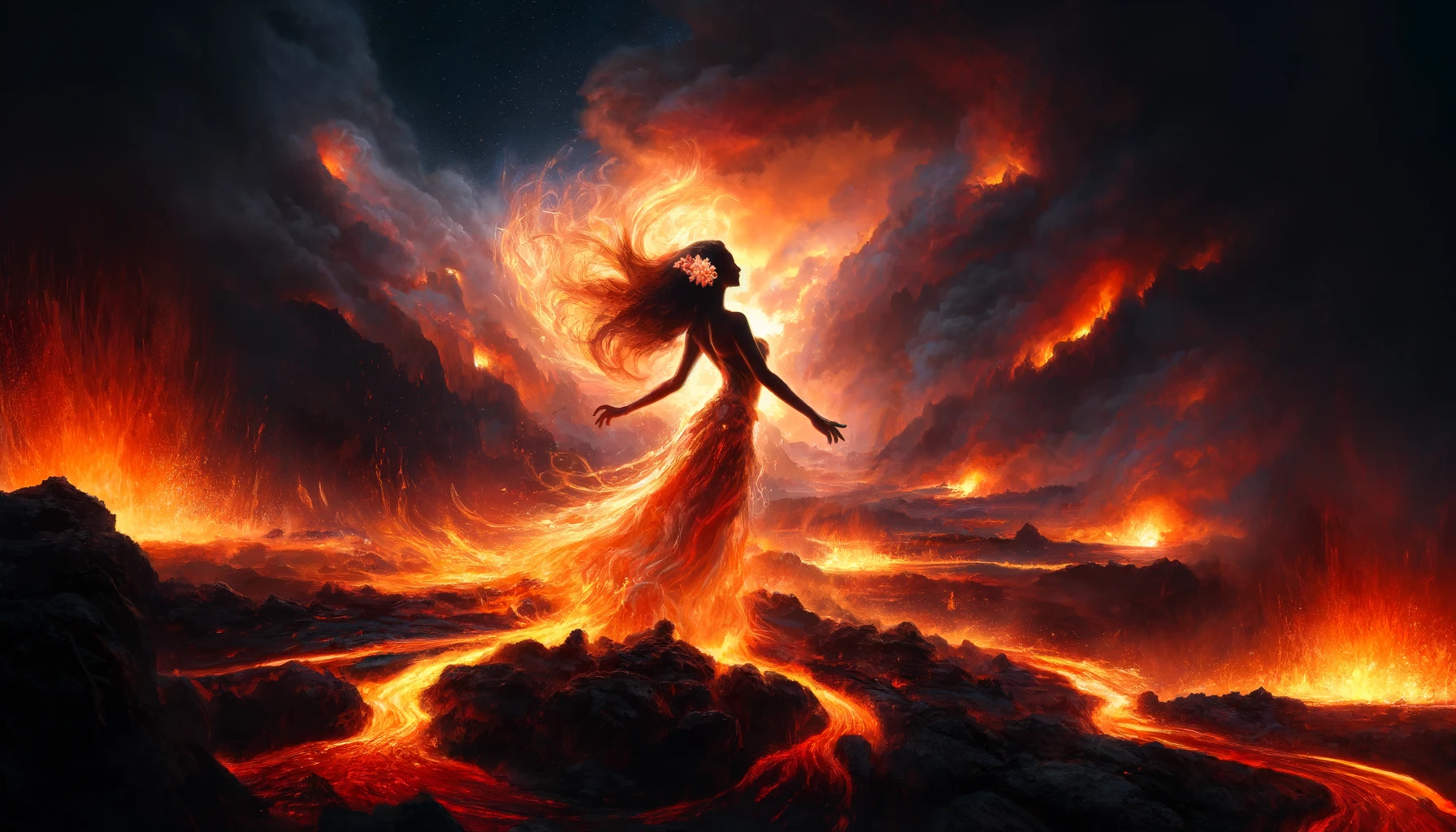 ‘Pele’s Dance: Flames of Creation’ captures the dynamic essence of Pele, the revered goddess of volcanoes in Hawaiian mythology. This digital artwork portrays Pele amid the molten flows of lava that cascade down the slopes of her volcanic home, illuminating the twilight skies with fiery orange and deep red hues. Her form, ethereal yet formidable, dances with the rhythm of the earth’s tremors, commanding the elements with every graceful yet powerful movement.
‘Pele’s Dance: Flames of Creation’ captures the dynamic essence of Pele, the revered goddess of volcanoes in Hawaiian mythology. This digital artwork portrays Pele amid the molten flows of lava that cascade down the slopes of her volcanic home, illuminating the twilight skies with fiery orange and deep red hues. Her form, ethereal yet formidable, dances with the rhythm of the earth’s tremors, commanding the elements with every graceful yet powerful movement.
The scene is set against a backdrop of a dramatically erupting volcano, with Pele at its heart, embodying both creation and destruction. Her figure is rendered with a blend of photorealistic and impressionistic digital brushwork, highlighting the swirling lava and crackling flames that follow her dance. The color palette is rich with the intense colors of fire—burnt oranges, fiery reds, and deep blacks—contrasted against the darkening skies.
This piece not only celebrates the might of Pele but also delves into the cultural significance of volcanoes in Hawaiian lore as creators of new land and as symbols of natural power. ‘Pele’s Dance: Flames of Creation’ invites viewers to experience the mesmerizing beauty and raw power of nature, portrayed through the mythical lens of one of Hawaii’s most iconic deities.”
This description aims to immerse the viewer in the powerful and majestic world of Pele, blending natural phenomena with the cultural mystique of Hawaiian legends.
Baba Yaga: Echoes of the Enchanted Forest
![]() ‘Baba Yaga: Echoes of the Enchanted Forest’ unveils the enigmatic world of Baba Yaga, the formidable witch of Slavic folklore. This digital artwork captures her residing in her iconic hut on chicken legs, hidden deep within the dense, whispering woods. Baba Yaga is portrayed as a complex character, both feared and revered, embodying the duality of nature—creator and destroyer, bringing both healing and doom.
‘Baba Yaga: Echoes of the Enchanted Forest’ unveils the enigmatic world of Baba Yaga, the formidable witch of Slavic folklore. This digital artwork captures her residing in her iconic hut on chicken legs, hidden deep within the dense, whispering woods. Baba Yaga is portrayed as a complex character, both feared and revered, embodying the duality of nature—creator and destroyer, bringing both healing and doom.
The scene is set at twilight, casting long shadows and painting the forest in hues of twilight blue and muted greens, pierced by the occasional glint of fading sunlight. Baba Yaga herself is depicted amidst a swirl of magical energies, her face a tapestry of wisdom and mystery, surrounded by various arcane artifacts that tell of her deep connection to magical realms.
The artwork melds intricate digital brushwork with dynamic 3D modeling, creating a textured, lifelike depiction of the Slavic wilderness. Subtle animations in the digital medium bring the scene to life: the rustling of the leaves, the eerie creaking of the hut, and the flickering of Baba Yaga’s fire. This piece not only draws on the rich tapestry of Slavic myths but also invites viewers to delve into a world where folklore meets the mystical, urging them to ponder the ancient stories passed down through generations.
‘Baba Yaga: Echoes of the Enchanted Forest’ is more than just a visual work; it is an invitation to explore the ambiguous moralities and wisdom of the crone witch, whose stories are interwoven with the very fabric of Slavic cultural heritage.
Kitsune: Whispers of the Moonlit Grove
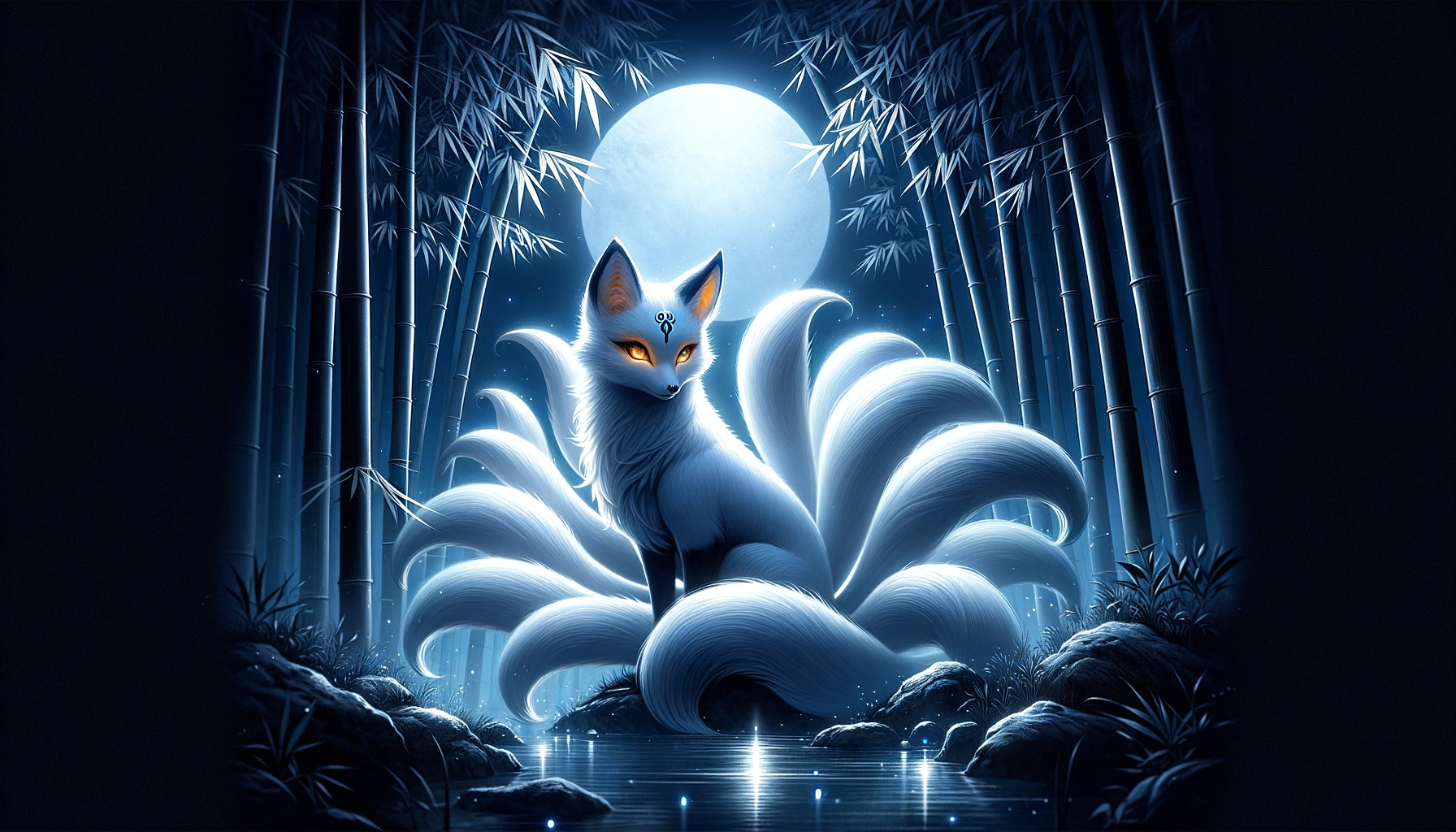 Kitsune: Whispers of the Moonlit Grove
Kitsune: Whispers of the Moonlit Grove
Description:
“‘Kitsune: Whispers of the Moonlit Grove’ is an ethereal digital artwork that explores the mystical allure of the Kitsune, the legendary fox of Japanese folklore. This piece portrays a nine-tailed Kitsune in a serene, moonlit bamboo grove, where the boundaries between the earthly and the spiritual blur. The Kitsune, cloaked in an aura of gentle luminescence, stands as the guardian of the forest, watching over the myriad forms of life that dwell within.
The artwork is a fusion of digital brushwork and subtle 3D elements, which bring a lifelike depth to the moonlit grove. Soft shades of silver and blue dominate the scene, reflecting the quiet mystery of the night, while hints of amber in the Kitsune’s eyes suggest the creature’s supernatural insight. Each tail of the Kitsune shimmers with a faint glow, symbolizing its wisdom and magical powers.
Designed to capture the enchanting and somewhat elusive nature of the Kitsune, this piece invites viewers to lose themselves in the beauty and mystery of Japanese myths. The Kitsune is not just a figure of intrigue but also a symbol of protection and cunning, embodying the complexities of nature and spirituality that are central to Japanese folklore.”
This description aims to immerse the viewer in the captivating and enigmatic world of the Kitsune, enhancing the mystical and cultural richness of the artwork.
Background on Kitsune in Japanese Folklore:
Origins and Meaning: Kitsune (狐) is the Japanese word for fox. Foxes are a common subject of Japanese folklore, depicted as intelligent beings possessing magical abilities that increase with their age and wisdom. According to Yokai folklore, all foxes have the ability to shapeshift into human form, and as they grow older and wiser, they may gain additional tails. A Kitsune can have up to nine tails, and a nine-tailed fox is considered particularly powerful and is seen as a symbol of immense wisdom and magical strength.
Spiritual and Supernatural Beliefs: Kitsune are often categorized into two main types: the zenko (善狐, “good foxes”) and the yako (野狐, “field foxes”). Zenko are benevolent, celestial foxes associated with Inari, the Shinto deity of fertility, prosperity, and rice. They serve as Inari’s messengers and are believed to protect the deity’s shrines and worshippers. Conversely, yako are often mischievous or malevolent, playing tricks on unsuspecting humans or possessing them, but these actions can also serve as lessons in humility or retribution for bad deeds.
Cultural Impact: Kitsune are prominent in numerous folktales and continue to be popular in modern Japanese culture, appearing in manga, anime, and film. They are often depicted as complex figures who can be both tricksters and protectors, reflecting their dual nature in folklore.
Folktales and Stories: One famous folktale is the story of Tamamo-no-Mae, a beautiful woman who was revealed to be a nine-tailed fox in disguise, using her bewitching powers to seduce and manipulate emperors. Another popular tale involves a kind old man who shares his food with a hungry fox, who later returns the favor by transforming into a beautiful woman and becoming his wife, helping him gain fortune and favor in his village.
Symbolism and Representation: In art and literature, Kitsune are often depicted amidst autumn leaves and full moons, which align with their mystical and enigmatic qualities. They may carry keys in their mouths, symbolizing their role as protectors of granaries and their association with Inari, or be shown with a scroll or a jewel, representing wisdom and magical abilities.
Cernunnos: Lord of the Wild and Guardian of the Gate
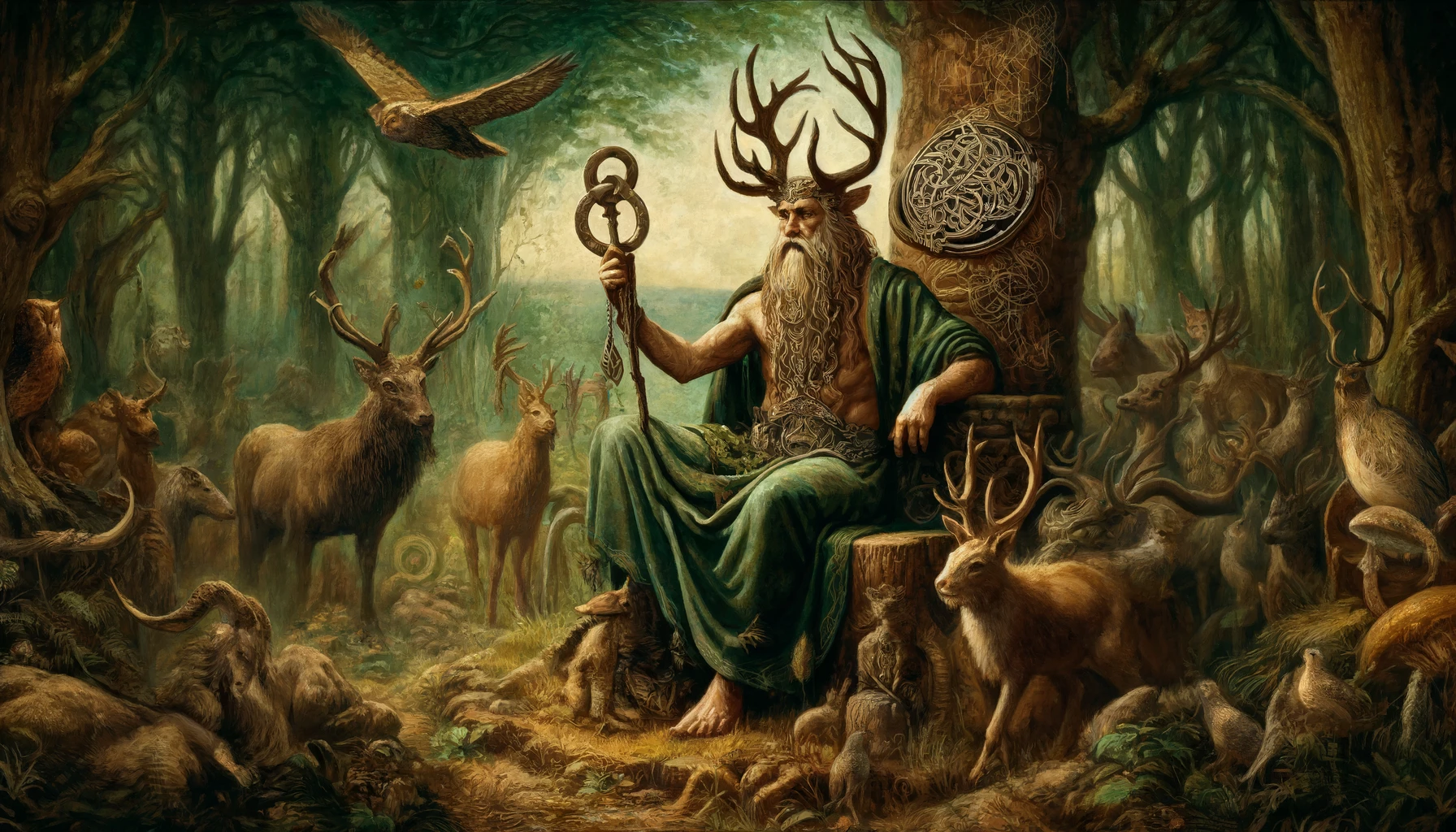 Cernunnos: Lord of the Wild and Guardian of the Gate’ is a captivating digital artwork that delves into the heart of Celtic mythology. It portrays Cernunnos, the enigmatic deity with antlers, symbolizing nature’s sovereignty and the cyclic nature of life and death. Seated in a lush, enchanted forest, surrounded by various creatures of the wood, Cernunnos is depicted in a moment of serene omnipotence, holding a torc in one hand and a serpent in the other, representing wealth and rebirth respectively.
Cernunnos: Lord of the Wild and Guardian of the Gate’ is a captivating digital artwork that delves into the heart of Celtic mythology. It portrays Cernunnos, the enigmatic deity with antlers, symbolizing nature’s sovereignty and the cyclic nature of life and death. Seated in a lush, enchanted forest, surrounded by various creatures of the wood, Cernunnos is depicted in a moment of serene omnipotence, holding a torc in one hand and a serpent in the other, representing wealth and rebirth respectively.
This digital painting is crafted with a harmonious blend of traditional brushwork and advanced 3D modeling, creating a rich, textured appearance that brings the forest and its mystical inhabitants to life. The color palette features deep greens and earthy browns, punctuated by the golden hues of the torc and the glistening scales of the serpent, enhancing the mythical atmosphere.
Each element of the artwork is meticulously designed to evoke the ancient Celtic belief in the interconnectedness of all life, inviting viewers to step into a world where the boundary between the physical and the spiritual is blurred. ‘Cernunnos: Lord of the Wild and Guardian of the Gate’ not only pays homage to the Celtic god but also invites contemplation on the deeper connections between humanity and the natural world.
For more background on this check out –> https://irishwishes.com/cernunnos/
Echoes of Anubis: Guardianship of the Underworld
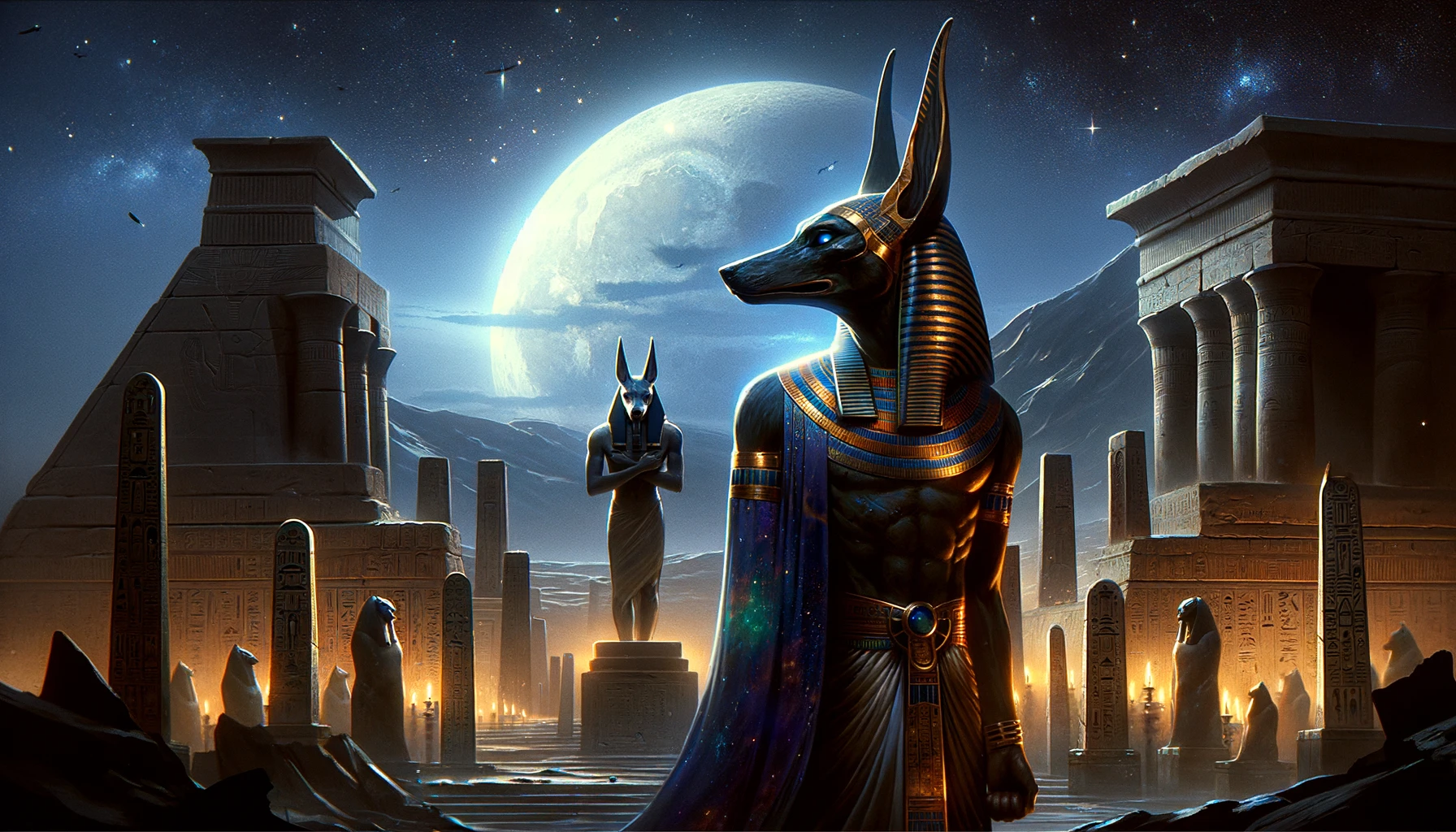 ‘Echoes of Anubis: Guardianship of the Underworld’ plunges into the rich tapestry of Egyptian mythology, showcasing Anubis, the jackal-headed god of mummification and the afterlife. This digital artwork captures the solemn majesty of Anubis standing guard at the gates of the underworld, set against the sprawling necropolis.
‘Echoes of Anubis: Guardianship of the Underworld’ plunges into the rich tapestry of Egyptian mythology, showcasing Anubis, the jackal-headed god of mummification and the afterlife. This digital artwork captures the solemn majesty of Anubis standing guard at the gates of the underworld, set against the sprawling necropolis.
The piece is created with a mix of digital brushwork and photorealistic textures, highlighting the stark contrasts between the ethereal glow of the spirit world and the gritty reality of the tomb-laden landscape. The palette is dominated by dusky golds, deep blacks, and the vibrant blues of lapis lazuli, commonly used in royal Egyptian artifacts.
Each element of the artwork—from the reflective sheen on Anubis’ ceremonial adornments to the shimmering stars of the night sky— is carefully crafted to bring out the mystical aura of ancient Egypt. The artwork not only depicts Anubis in his traditional role but also imbues the scene with a sense of eternal vigilance, inviting viewers to ponder the mysteries of life and death as seen through the eyes of ancient civilizations.
‘Echoes of Anubis: Guardianship of the Underworld’ is more than just a visual piece; it is a portal to the past, blending historical iconography with modern artistic techniques to create a scene that resonates with the power and mystique of Egyptian mythology.
